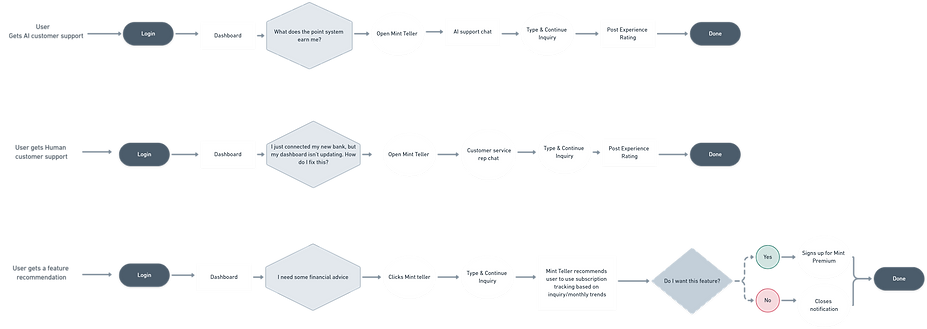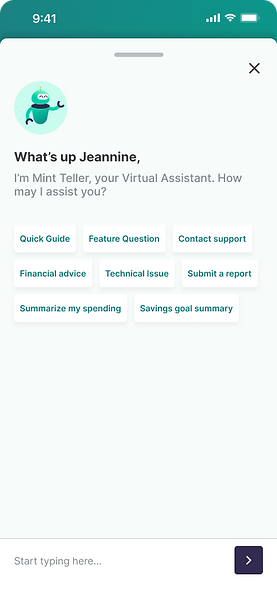A customer service chatbot that assists in-app users
Mint Teller

Project Overview
Mint by Intuit is a fintech app that allows people to track and budget their expenses. It's trusted by over 24 million users. As a single person, I chose to design an added feature for this product which was intended for UX and UI practicum.
Role
UX Researcher | UX/UI Designer
Scope
80 hours
Tools
Figma | Canva | Maze
SUMMARY
The Problem
Many users have reported a lack of customer service and complicated UX causing them to ditch the app.
The Solution
A reliable customer service chatbot that aligns with Mint's current UI and brand. It is for users to feel like they can depend on Mint for help without the endless scrolling through FAQs
.png)
.png)
.png)

USER RESEARCH
What Do Users Want?
To kick start this project, I looked over some of their recent critical reviews to understand the direct causes of user frustration. I've discovered the following patterns which sparked my design thinking...
"Accounts don't refresh..." "doesn't update paid debts."
1 | Technical Issues
Many users report having some kind of technical issue which affected their experience with mint.
"They will totally ignore you."I've been using this app for about 10 years...there is no customer service."
2 | Lack of customer support
Users reported that they couldn't reach the support team.
Understanding the Market
Next, I analyzed and compared some of Mint's top competitors using a competitive analysis. This was done to understand their customer service approach while also noting common design patterns.
Key Findings
-
Rocket Money and Nerdwallet also lack in-app customer service. Users have to utilize FAQs or fill out contact forms.
-
Secondary competitors like US Bank utilize Voice Assist as a form of customer service. This in turn causes some users to ditch (or never download) Mint as they may be already satisfied with the features their bank offers.
These findings have given me insights into a potential solution for Mint, Voice AI. My next move was to validate the hypothesized solution.
Problem & Solution Validation with Interviews
3 participants who are past or current users of Mint were recruited and asked questions pertaining to Voice AI assistance. The goals during this process were to:
-
Validate the projected solution
-
Discover more user pain points in relation to mint and customer service AI.


This interview gave me crucial insights into a few things:
-
I had a leaning bias toward developing a feature pertaining to voice AI. Big oops! I touch more on this in my lessons learned
-
Voice AI is not ideal for Mint users at this time since users prefer to type their information privately.
-
Some people aren't aware of all the features a fintech app offers
How might we design a private & reliable solution that provides readily customer support where users can report to and potentially solve their inquires.
DEFINE
A New Viable Solution
The most viable solution was a customer support chatbot that provided relevant tips, knowledge, and inquiry solutions. A feature like this can reduce customer service costs. I then decided to name this feature "Mint Teller" derived from how Bank tellers help customers with their bank inquiries.
Information Discovery
During this stage, I discovered that according to Forbes, up to 86% of people prefer humans over chatbots. This was a minor setback, so how can I find the middle ground?
User Perspective
It was important to then map out how Mint Teller can improve the experience of an existing user audience. This journey map depicts two people navigating Mint, alongside the room of opportunities.


Mint Teller can improve the customer experience through the following tasks:
-
Users getting quicker help for technical difficulties
-
Users opting for transfer to a live human representative
-
Users learning more about existing features and metrics
-
Users receiving recommendations and advice based on their inquiries
Identifying Key Features
Based on common design patterns, I generated this roadmap to demonstrate what the chatbot can offer as a new feature. The red and yellow features were my top design priorities. I plan to implement common design functions like quick inquiry categories and a new feature onboarding.

Mapping out the Tasks
Here are Mint Tellers' key task flows: AI customer support, Human customer support, and feature recommendation. I imagined myself being a confused or frustrated customer therefore, I found it important to keep the flows as straight-forward as possible for faster service.
.png)
IDEATION
Establishing the vision
In order to began brainstorming the design ideas, I used these key reference screens. From here, I was able to discover Mint's current design system alongside common design patterns for AI Chatboxes.

New Feature Alert
Mint notifies of new features using pop-screens and pink alert tags
Text Shortcuts
Common inquiry options are shown upon opening
User Ratings
Post experience ratings pop up after the user closes the chat
Meet Mint Teller
Graphic design wasn't my focus on this so, I utilized a free graphics plugin on figma. I opted for friendly robot that was customized to fit right on brand. Check em' out!
The vision coming to life
Next, I generated the wireframes based on the key tasks. After some feedback, you will notice slight changes made in the high fidelity frames. I implemented Mint's current UI & color palette by using the reference screens and color dropping. The small details here really mattered!




USER TESTING
Is the feaure usable?
Other than the feature's usability, another priority during testing was to gain insights into how Mint Teller improves the customer service experience and its relevance to new and current users.
Method
-
Maze (Remote Testing)
-
Recruitment via Discord
Participants
16 total
Tasks
-
On-boarding
-
Feature Suggestion
-
Human Support Transfer
-
Post-Experience Rating
Metrics
-
Success Rate
-
Error Free Rate
-
Written Feedback
Test Results
Success Matrix
Quick Inquiry Topics
Mint Teller Icon
80-93% of participants chose to utilize them rather than typing.
The Mint Teller icon location was successful due to a low misclick rate of 20%
Would users actually use it?
Would it improve Mint's customer service?
100% of testers would use this feature in a real-world setting.
100% of testers think Mint Teller could provide better customer service for Mint.
View full test findings report
ITERATION
Affinity Mapping
I don't think any design is perfect the first go-round. So, I gathered all of the participant's feedback and grouped them into the corresponding topics. Here I was able to pinpoint 4 areas that needed revisions.

High Priority Revisions
Here are the systemized solutions that were integrated into Mint Teller based on the Affinity map.

FINAL DESIGNS
Welcome to Mint Teller!
You can explore the prototype by clicking the button below...
.png)
.png)
.png)
.png)


REFLECTION
Conclusion & Positioning
This concludes the process up to the hand-off of the first version of this new feature but continues beyond with additional testing, feedback, and revising. Mint Teller can grow by adding even more in-app tasks and foreign language processing, improving user experiences and Mint's business goals.
Lessons Learned
Bias & Assumptions
Through the user interviews, I was able to realize that I had an unintentional bias for a feature that many people could've potentially not even used. A mistake like that will cost! For future projects, I've learned to embrace not knowing what the solution is which is why research is highly emphasized.
Integrate into Existing UI
Because I was solely implementing a new feature into Mint's existing app, I had to pay extra attention to the little details like typography, spacing, and grids. Doing extra research into Mint's UI was definitely worth the time because it was tempting to jump right into high-fidelity wireframes.
Real-World Cost Effectiveness
I'm aware that a feature that offers both AI and Human chat support would be costly. However, with proper optimizations, I believe that chatbots can evolve to be more dependable for people thus removing the demand for more Human Support. (Sorry peeps!)